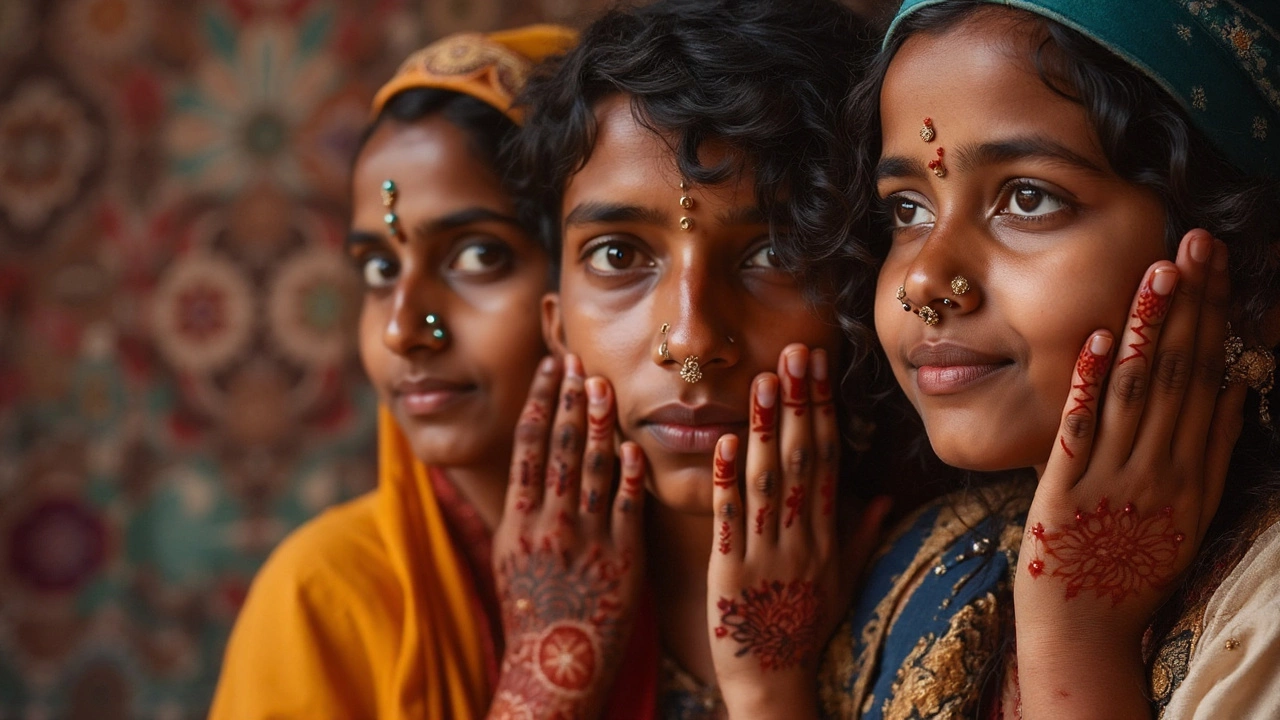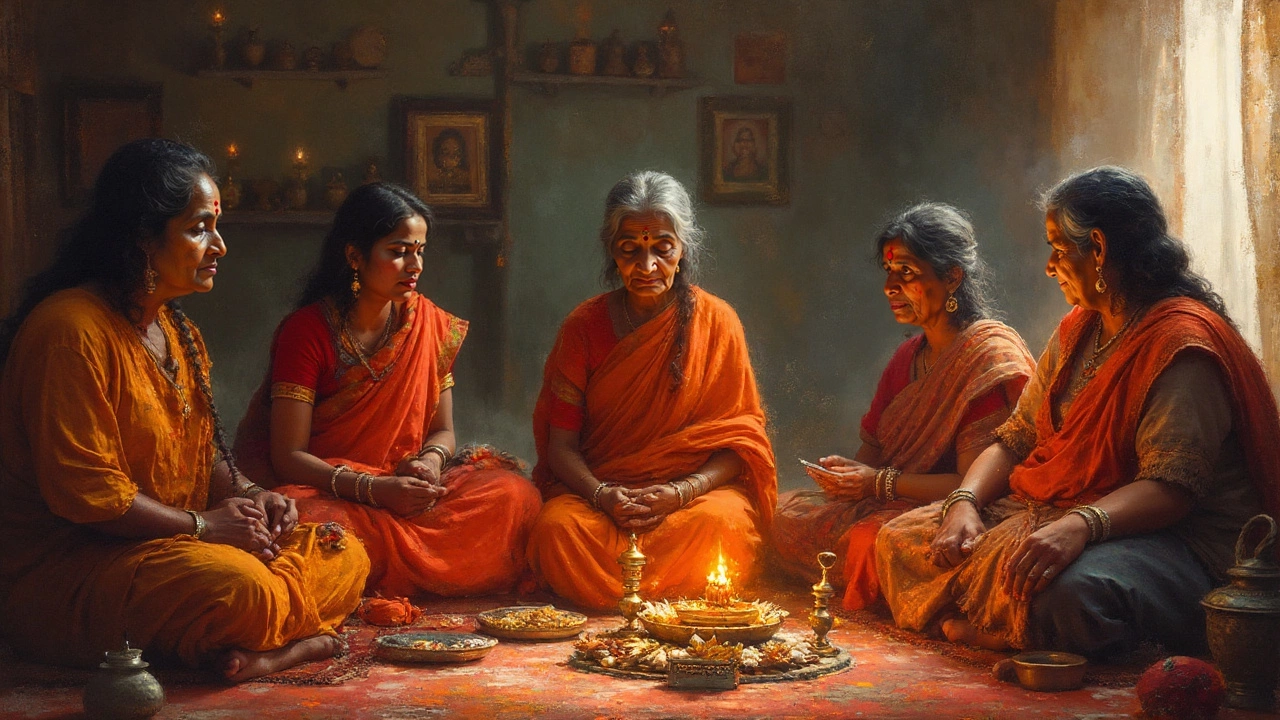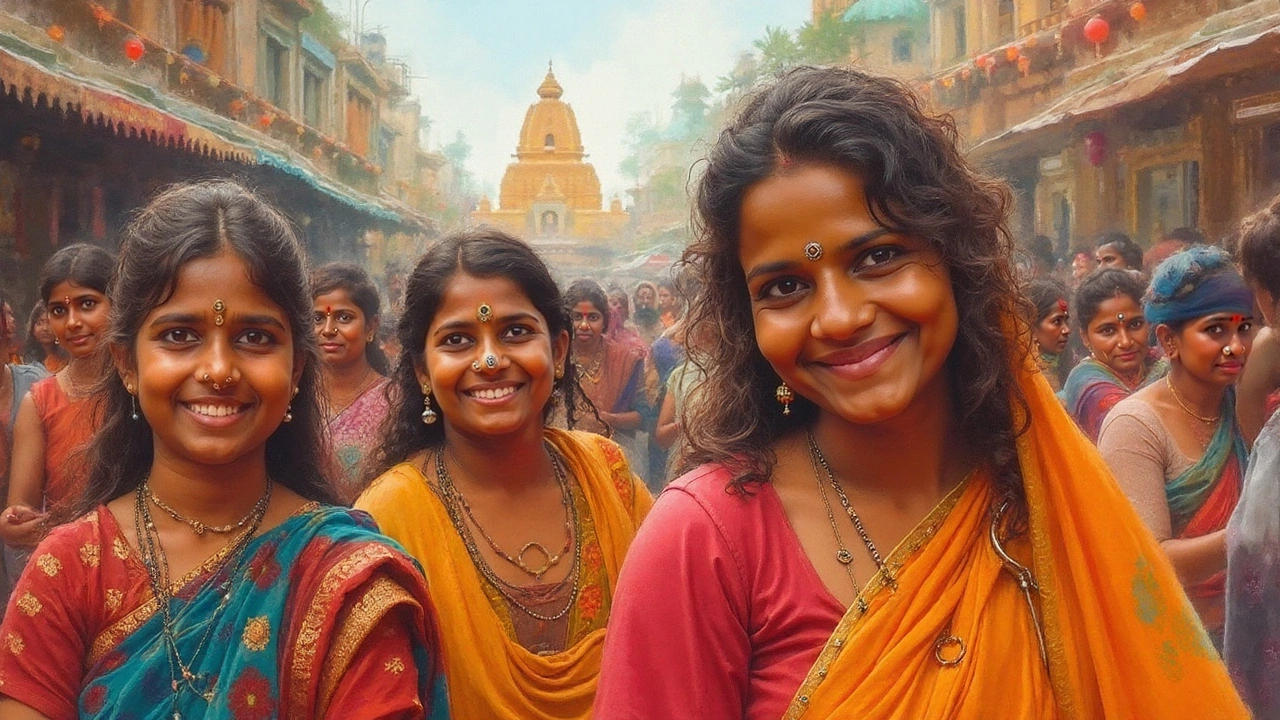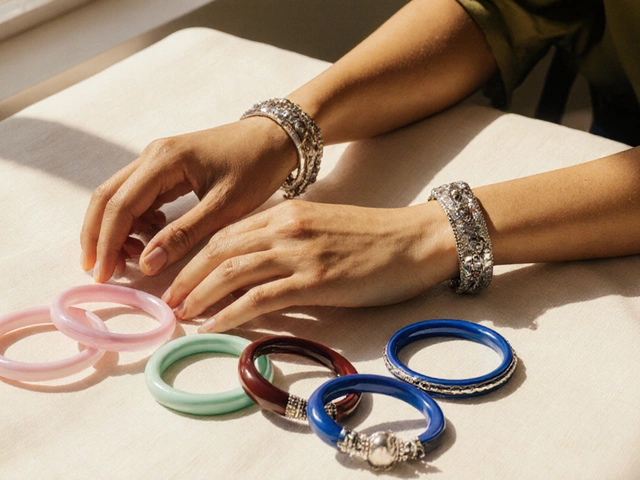Ever noticed how a single nose stud can spark a world of stories, faith, and ancient customs? What some see as just a fashion trend is actually a centuries-old symbol loaded with ritual and belief. It’s not just in movies or Instagram reels—walk down the streets in parts of India, Nepal, or Pakistan and you’ll quickly spot a shining dot or stud in a nose, each carrying a tale. This humble piece of jewelry isn’t random. It sits at the intersection of faith, ceremony, and family legacy. And it isn’t limited to one belief system. Let’s dig in and uncover how nose studs are woven into religious identities around the globe.
The Religious Roots of Nose Studs
Long before nose studs sold out on trendy e-commerce sites, people wore them as part of ritual and religion. But where did it begin? The answer: South Asia, especially among Hindus. The origin of nose piercing in India can be traced back to the Vedic period, around 1500 BCE. Nose piercings and studs, called 'nath' in Hindi, are common in Hinduism, mainly among women. This isn’t just for fashion; it’s religious symbolism at work. In fact, one of the first written references comes from Ayurvedic texts, where the left nostril is said to be connected to female reproductive organs, supposedly easing childbirth and menstruation pain. Ask any auntie at an Indian wedding and she’ll confirm that it’s part tradition, part faith, and part practicality.
Islamic culture also gives a respectful nod to nose studs. In many Muslim-majority countries, like Pakistan or Bangladesh, nose studs are donned by brides as a part of the wedding ceremony. It’s said that the Prophet Muhammad’s wives wore nose rings, and that set a lasting example. However, there’s a twist: not all Islamic scholars see it the same way. Some encourage it as a symbol of marital status and tradition, while others don’t specifically endorse it for religious reasons—but the custom still thrives. Ask a Bangladeshi grandma why she wore a nose stud for her wedding, and you’ll hear how it connects her to her faith, family, and ancestry.
Other religions? You’ll spot nose studs on Nepalese Buddhist women too. Though not explicitly religious in Buddhist texts, the tradition seeped into Buddhist culture from local customs, merging spiritual symbolism with cultural identity. Even in tribal regions across Africa, nose ornaments have roots in animist religions—these are symbols of status, maturity, or a signal of readiness for marriage. Judaism and Christianity generally don’t feature nose studs as a religious symbol, but there are rare exceptions and modern reinterpretations, especially as fashion blends with tradition.
| Religion | Use of Nose Studs | Main Symbolic Meaning | Predominant Regions |
|---|---|---|---|
| Hinduism | Common, religious and cultural | Purity, marriage, feminine power | India, Nepal |
| Islam | Popular, cultural, sometimes religious | Marriage, beauty, family honor | Pakistan, Bangladesh, Middle East |
| Buddhism | Local traditions influence | Cultural identity, social status | Nepal, Tibet |
| Tribal African Religions | Widespread in tribes | Status, maturity, readiness for marriage | Parts of Africa |
Here’s a cool tidbit: In some parts of Rajasthan, India—a vibrant state known for its folk music and camel fairs—a bride’s wedding nose ring can weigh up to 20 grams. For them, this isn’t just bling, it’s one of the most meaningful parts of the wedding outfit, forging a visible link to family beliefs.
A widely cited statement on the cultural power of nose studs comes from Dr. Susan Scafidi, founder of the Fashion Law Institute:
"Nose piercings are a tiny but powerful signpost—marking religion, resistance, or a momentous life event, all depending on who’s wearing it."
So, while the nose stud is most visible in Hinduism and Islamic cultures, it turns up wherever ritual and roots run deep.

Cultural Meanings, Legends, and the Gender Angle
It’s not just about religion; nose studs hold layers of cultural weight. Hindu mythology, for instance, links nose ornaments to Parvati, the goddess of marriage. Wearing a stud or a ring near the left nostril is seen as invoking divine blessings for a long, happy marriage. It’s such a big deal that Hindu women in India often get their piercing done right before marriage or significant festivals. Rural legends even claim that a nose stud protects against the “evil eye.” Some families still bury nose rings with the deceased, as a sign that beauty and family honor follow into the next life.
Muslim women in South Asia have their own stories. For them, the stud is as much about beauty as piety. Married women sport a gold or diamond dot on their nostril, which acts as a visual signal that they are spoken for. It’s not uncommon for a mother-in-law to gift a nose stud to a new bride, sealing her entry into the family circle. My friend Yasmin, whose heritage is Pakistani, recalled her grandmother insisting on a nose piercing—"You won’t just wear tradition, you live it every day.”
In many African tribes, the nose stud (and often septum rings) carry entire lifetimes of meaning. For the Maasai of Kenya, a girl’s first nose ring is a badge of adulthood. Other tribes use elaborate nose pieces, crafted from bone or precious metal, to reflect social standing. The larger or more ornate the nose decoration, the higher one’s place in the tribe. And it’s not only for women—men in certain tribes sport nose pieces to signal bravery or readiness for marriage.
You’ll hear some eyebrow-raising myths too. There’s an old custom in parts of North India saying girls who pierce their left nostril will recover from a bad fever quicker. My wife, Maya, chuckles at this, but her mother swears by it—some things just don’t make much medical sense but are strong enough to become family rules.
What about outside of South Asia and Africa? Jewish and Christian texts don’t require or encourage nose jewelry, but some progressive or alternative groups see them as expressions of individuality or spirituality. For instance, in certain Christian circles, getting a nose piercing might symbolize a personal journey or memorialize a loved one. But these are outliers rather than mainstream religious norms.
In recent decades, there’s been a noticeable gender shift. While most religious and traditional customs focus on women, more men are getting nose piercings—sometimes as a throwback to ancient traditions, often just as personal or fashion statements. For example, Indian pop stars and cricketers sporting nose studs now create buzz and spark conversations about tradition flipping on its head. It wasn’t too long ago that nose studs for men in South Asia were considered taboo, but now, the lines are blurring. I remember when my cousin Amit went for a small gold stud as a symbolic nod to both his faith and his style. Family get-togethers suddenly got a lot more interesting, with elders debating whether this was a rebellious move or just the old ways coming back in a new package.
Even global pop culture has dipped into nose stud territory. Think of Tupac Shakur or Zayn Malik—icons who made nose jewelry a cool choice for guys everywhere. The fact that you can now find nose studs sold in chain stores worldwide is a testament to how religious and cultural roots sometimes become fashion statements, trekking far from their origins but never entirely leaving them behind.
Here’s a quick list of cultural facts about nose studs:
- In South India, the nose ring is often worn on the right nostril instead of the left due to local traditions.
- Maharashtrian brides wear a distinctive, crescent-shaped nose ring called a 'nath'.
- In Afghanistan, rural women have adopted large nose hoops into their wedding customs, mixing tribal, Islamic, and regional traditions.
- In the West, nose studs gained popularity during the hippie movement of the 1960s and again in the punk subculture of the 1980s.
So, nose studs might be tiny, but they’re anything but simple. They’re loaded with stories—about gender, power, beauty, and resistance—depending on who’s wearing them and why.

Modern Life: Nose Studs in the 21st Century and How to Wear Them
Fast forward to today, and nose studs have gone global. What was once sacred or reserved for special occasions has become everyday, even in big cities like Melbourne where I live. You’ll spot people of every background with some shine on their nostril—sometimes tied to faith, other times just for the fun of it. What’s interesting is how many young people revive old traditions but put their own twist on them. My sister-in-law went for a geometric diamond stud for her wedding, which turned heads in our family WhatsApp group. Half the aunties loved the "modern take," the others wanted a classic flower design. Everyone has their own opinion—and that’s the point.
If you’re thinking about getting a nose stud for religious reasons, what should you consider? For Hindus, tradition points to the left nostril. Most Hindu women choose gold, as it’s seen as auspicious and matches well with traditional wedding jewelry. Islamic tradition leans toward the right nostril, but this varies by region. Silver is also common, symbolizing modesty and purity. Of course, you can get creative—as long as your family (and possibly your mother-in-law) is okay with it.
Health and hygiene are super important. The tradition is old, but modern piercing needs new-age care. Always go to a professional piercer who sterilizes their equipment. Keep the area clean, avoid heavy makeup for a few weeks, and resist the urge to twist or turn the stud. A 2022 study in the Australian Journal of Dermatology reported that about 15% of infections happen because people touch their fresh piercings too often. Ouch!
Want to wear a nose stud as a cultural or fashion statement? There’s no rulebook, but here are a few tips to keep it cool and respectful:
- Learn the story: If you borrow from another culture, know the meaning behind the piercings—people appreciate when you’re thoughtful about their traditions.
- Pick the right size: Smaller studs are subtle and easy to care for. Larger pieces make a statement but need more attention (and confidence!).
- Metal matters: Gold, silver, diamond, or surgical steel—choose what’s safe for your skin and appropriate for the setting.
- Mind the workplace: Some jobs frown on visible piercings, so have a tiny, discrete stud for those occasions.
Even celebrities are giving ancient nose studs a modern twist. Remember when Rihanna showed up to an awards show with a sparkling Indian-style nath? That move sent Google searches for "celebrity nose studs" soaring, mixing red-carpet glam with spiritual symbolism.
Globally, it’s hard to keep track of how many people wear nose studs, but estimates from piercing industry insiders suggest more than 80 million women in India alone have their noses pierced. That’s more than the whole population of the UK. Just imagine the amount of gold, diamonds, and stories traveling on those faces every day. Add to that rising numbers in the US, Australia, and Europe, and it’s clear the nose stud isn’t fading out anytime soon—its traditions just keep morphing with every new generation.
Nose studs may have started as a badge of faith or cultural identity, but now they shine as both art and personal expression. Whether you’re wearing one because your grandmother did, because your faith asks you to, or simply for the vibe, you’re part of a tradition that stretches back thousands of years. All that meaning, in a single little sparkle.



